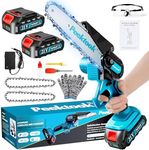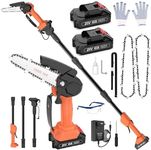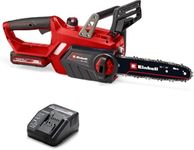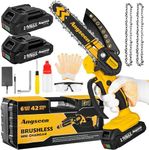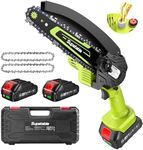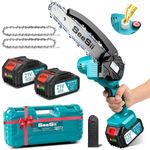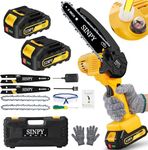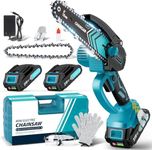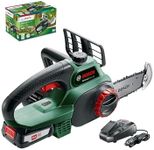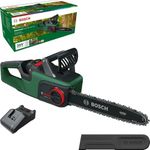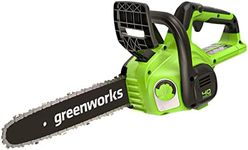Buying Guide for the Best Battery Chainsaw
When choosing a battery chainsaw, it's important to consider the specific tasks you plan to undertake, as well as your level of experience with chainsaws. Battery chainsaws are a great option for those who need a lightweight, portable, and easy-to-use tool for light to medium-duty cutting tasks. They are quieter and more environmentally friendly than gas-powered models, making them ideal for residential areas. To find the best fit for your needs, focus on the key specifications that will impact performance, usability, and convenience.Battery VoltageBattery voltage is a measure of the power output of the chainsaw. Higher voltage typically means more power, which can translate to better cutting performance. Battery chainsaws usually range from 18V to 80V. For light pruning and small branches, a lower voltage (18V-36V) may suffice. For more demanding tasks like cutting larger branches or small trees, a higher voltage (40V-80V) is recommended. Consider the type of work you will be doing most often to determine the appropriate voltage for your needs.
Battery Capacity (Ah)Battery capacity, measured in ampere-hours (Ah), indicates how long the battery can run before needing a recharge. A higher Ah rating means longer runtime. Chainsaws typically have batteries ranging from 2.0Ah to 5.0Ah or more. If you plan to use the chainsaw for extended periods or have a lot of cutting to do, opt for a higher capacity battery. For occasional use or smaller tasks, a lower capacity battery may be sufficient. Consider how long you need the chainsaw to operate on a single charge to choose the right capacity.
Bar LengthThe bar length of a chainsaw determines the size of the wood it can cut in a single pass. Battery chainsaws generally have bar lengths ranging from 10 to 18 inches. A shorter bar (10-12 inches) is suitable for light pruning and small branches, while a medium bar (14-16 inches) can handle larger branches and small trees. For cutting larger trees or logs, a longer bar (16-18 inches) is more appropriate. Choose a bar length based on the size of the wood you expect to cut most frequently.
Chain SpeedChain speed, measured in meters per second (m/s) or feet per minute (fpm), affects how quickly and efficiently the chainsaw can cut through wood. Higher chain speeds generally result in faster cutting. Battery chainsaws typically have chain speeds ranging from 5 m/s to 15 m/s. For general yard work and light cutting, a lower chain speed may be adequate. For more demanding tasks or to achieve faster cuts, look for a chainsaw with a higher chain speed. Consider the type of cutting you will be doing to determine the necessary chain speed.
WeightThe weight of a battery chainsaw affects its ease of use and maneuverability. Lighter chainsaws are easier to handle, especially for extended periods, and are ideal for users who may not have a lot of upper body strength. Battery chainsaws typically weigh between 7 to 15 pounds. If you plan to use the chainsaw for long durations or need to work in awkward positions, a lighter model may be more comfortable. For heavier-duty tasks, a slightly heavier chainsaw might offer more stability and control. Consider your physical capabilities and the nature of your tasks when choosing the weight.
Safety FeaturesSafety features are crucial in a chainsaw to prevent accidents and injuries. Common safety features include chain brakes, low kickback chains, and hand guards. Chain brakes stop the chain quickly in case of kickback, while low kickback chains reduce the risk of sudden movements. Hand guards protect your hands from debris. When choosing a chainsaw, prioritize models with robust safety features, especially if you are a beginner or will be using the chainsaw frequently. Consider your experience level and the importance of safety in your work environment when evaluating these features.
